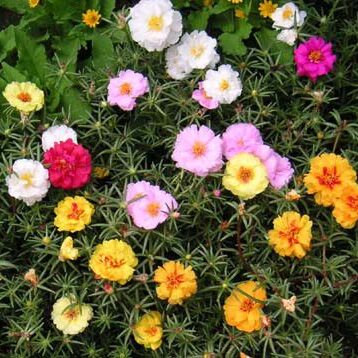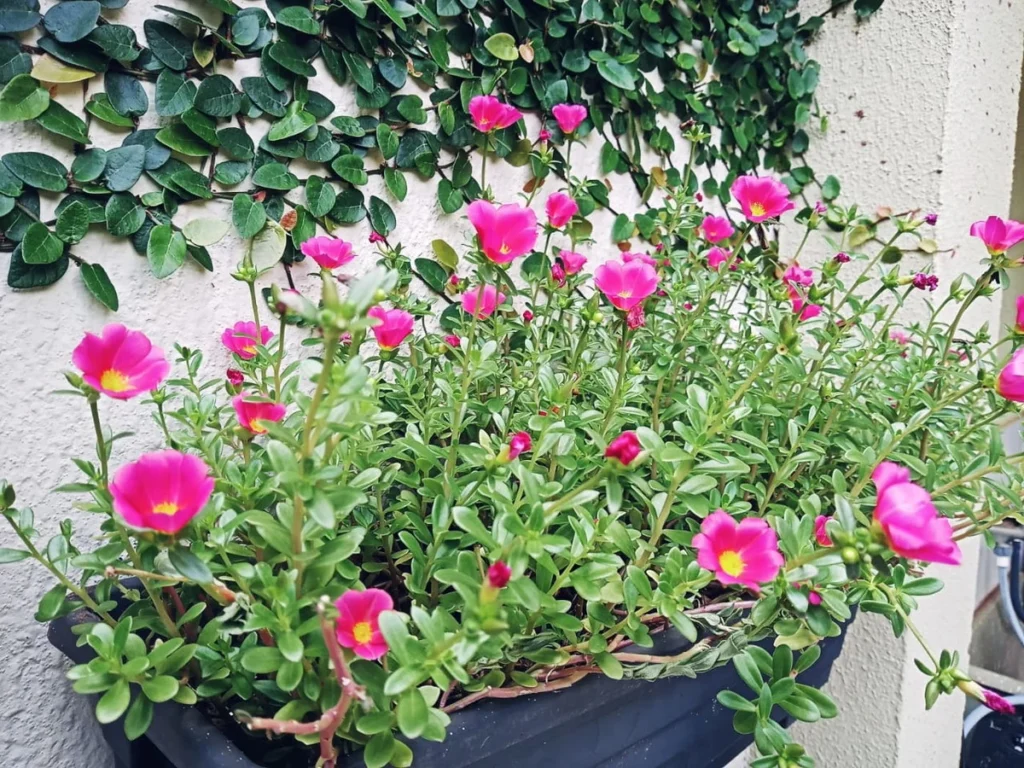Rose Moss (Portulaca grandiflora) is a charming annual succulent plant, known for its beautiful colorful flowers that open during the day and close at dusk, remaining so until the next morning. Originally from Brazil, the Rose Moss is an excellent choice for gardeners looking for a plant that is easy to grow and brings an explosion of color to the environment.
index
| Common Name | Rose Moss |
|---|---|
| Botanical Name | Portulaca grandiflora |
| Family | Portulacaceae |
| Type of Plant | Annual succulent |
| Adult size | About 10 to 15 cm high |
| Solar Exhibition | Full sun |
| Soil Type | Light, well-drained and sandy |
| Soil pH | Neutral to slightly alkaline (6.5 to 7.5) |
| Flowering Season | Spring to fall |
| Color of Flowers | Pink, red, yellow, orange, white |
| Native Area | Brazil |
| Toxicity | Non-toxic |
| Fonte: wikispecies |

Caring for the Rose Moss
Rose Moss (Portulaca grandiflora) is an easy-to-grow and easy-to-care-for plant, making it a great choice for those who want to add vibrant colors to their garden or pots. Here are the main precautions to ensure the good development of this beautiful succulent:
Light
This plant loves direct, intense sunlight. Make sure you place the plant in a spot where it receives at least 6 hours of sunlight a day. This adequate exposure to sunlight will ensure lush and prolonged flowering.
Soil
The soil for Rose Moss should be light and well-drained. Opt for substrates with good aeration that allow water to flow easily, preventing the roots from becoming waterlogged.
Water
This succulent is drought-resistant and prefers drier soil to waterlogged soil. Water moderately, only when the soil is dry on the surface. Avoid excessive accumulation of water in the pot, as waterlogging can lead to root rot.
Temperature and humidity
The Rose Moss is adapted to warm, sunny climates. It does not tolerate frost or very low temperatures. Keep the plant in places with temperatures between 20°C and 30°C. Humidity is not a concern, as this succulent is hardy and can cope well with drier environments.
Fertilization
Fertilizing the Rose Moss should be done sparingly. Use a balanced, slow-release fertilizer, following the manufacturer’s instructions. Avoid excess nutrients that could harm the plant. Fertilizing can be done once every two months during spring and summer, when the plant is in its growth and flowering phase.
What are the types of Rose Moss?
Rose Moss (Portulaca grandiflora) is a plant known for its variety of colors and shapes. There are several cultivars and varieties of this beautiful succulent, each with its own unique characteristics. Below, we present some of the main types of Rose Moss:
- Rose Moss Simple: With its star-shaped flowers and vibrant colors, it is the most common form of the plant.
- Rose Moss Folded: It has flowers with petals in the shape of double rosettes, creating a more voluminous and charming effect.
- Rose Moss Pendant: This variety has longer, more flexible stems, perfect for growing in hanging pots.
- Rose Moss Moss: Is a compact version of the plant, ideal for small spaces and garden borders.
- Rose Moss Variegata: Is characterized by leaves with variegated edges or stripes, adding a touch of elegance to the environment.
- Rose Moss Bicolor: Flowers with contrasting colors, such as petals with a lighter tone in the center and a more intense color at the edges.
These are just a few of the countless variations of the Rose Moss succulent available on the market. Each type brings its own unique beauty and charm, making it an excellent choice for those wishing to diversify their garden or succulent collection.


Pruning: Importance and Techniques
Pruning is an essential practice to keep your plant healthy and growing vigorously. By pruning correctly, you can stimulate flowering, control the size of the plant, and remove damaged parts. In addition, regular pruning contributes to a more compact and beautiful appearance for Rose Moss. The main pruning techniques for this plant are:
- Removing wilted flowers: By removing flowers that are past their prime, the plant directs its energy towards producing new flowers, prolonging the flowering period.
- Cutting back dry or damaged stems: Pruning dry or damaged parts allows the plant to redirect nutrients to healthy areas and promotes the development of new shoots.
Methods of Propagation
Propagating the Rose Moss can be done in a variety of ways, and the good news is that this plant reproduces easily. Some of the most common methods for propagating these plants are:
- Cuttings: Remove a healthy portion of the plant’s stem and let it dry for a few hours before planting it in a new pot.
- Clump division: Carefully separate lateral shoots or new seedlings growing close to the mother plant and replant them individually.
Step-by-step on how to plant
Below is a step-by-step guide to planting Rose Moss successfully:
- Choice of location: Choose a place that receives direct or indirect sunlight, as the Rose Moss prefers well-lit environments.
- Soil preparation: Make sure the soil is well-drained and rich in organic matter to ensure healthy root development.
- Planting: Dig a small hole in the ground and place the Rose Moss seedling or cutting, covering the roots with soil and pressing lightly.
- Watering: Keep the soil slightly damp after planting and avoid waterlogging the plant.
- Post-planting care: Protect the plant from strong winds and monitor its growth to ensure that it is adapting to its new environment.
By following these guidelines, you can enjoy beautiful flowers and the charm of the Rose Moss in your garden or green space.

Most common pests and diseases
Rose Moss is a resistant plant, but just like any other, it is susceptible to some pests and diseases. Knowing the most common threats that can affect your plant will allow you to act quickly to avoid major problems. Some of the most common pests and diseases are:
- Mealybugs: Small sucking insects that can cause leaf spots and weaken the plant.
- Mites: They can multiply quickly and cause damage to the leaves, leaving them yellowed or dry-looking.
- Powdery mildew: Fungus that creates a whitish coating on the leaves, impairing photosynthesis.
Common Problems and Their Solutions
When growing the Rose Moss, you may come across some common problems, but they can be easily solved. Here are some issues that may arise and their solutions:
- Withered or yellowed leaves: This could be the result of a lack of water. Increase the frequency of watering, but avoid soaking the soil.
- Damaged or spotted leaves: This can be caused by pests such as mealybugs or spider mites. Carry out a careful inspection and, if necessary, treat the plant with a specific insecticide.
Advanced Care and Maintenance Tips
In addition to basic care, there are some advanced tips for keeping the Rose Moss even healthier and more lush:
- Fertilizing: Use a balanced fertilizer during the period of active growth to stimulate flowering and leaf development.
- Protection against intense cold: This plant is sensitive to cold. If the weather is too harsh, move the plant to a sheltered area or cover it at night.
- Humidity control: The plant likes an environment with adequate humidity levels. If the air is too dry, spray the leaves with water regularly.
With this information and additional care, you’ll be ready to grow and enjoy the beauty of the Rose Mossin your home or garden.
Curiosities and myths
The Rose Moss is a fascinating plant, full of curiosities and interesting myths surrounding it. Find out some curious information about this beautiful plant:
- Variety of Colors: There are different varieties of Rose Moss, with flowers in a variety of vibrant colors, such as pink, red, yellow, white and orange.
- Landscaping: Due to its beauty and easy cultivation, Rose Moss is often used in landscaping projects, decorating gardens, flowerbeds and pots.
- Touch Sensitivity: The leaves of Rose Moss have the peculiarity of closing when touched or exposed to sudden movements, as a form of protection.
Conclusion
The Rose Moss is a charming plant that has unique characteristics and is easy to care for. With its beautiful tones and flowers that open and close throughout the day, it brings a special touch to green spaces. To grow this plant successfully, remember the following points:
- Rose Moss requires direct or partial sunlight to thrive.
- The soil should be well-drained and rich in organic matter.
- Water the plant regularly, keeping the soil slightly damp.
- It likes mild temperatures and high relative humidity.
- Fertilize during the period of active growth.
With this information in mind and advanced care tips, you’ll be ready to grow and enjoy the beauty of the Rose Moss in your home. Add this enchanting plant to your collection and enjoy its stunning flowers and attractive leaves in your environment
Perguntas Frequentes
What time does the Rose Moss close?
The Rose Moss flower usually closes around 11 o’clock at night, hence the popular name “eleventh-hour”. They have a habit of opening in the morning, around 11 o’clock, and remaining open during the day, closing in the early evening.
How to care Rose Moss in a vase?
To take proper care of eleven o’clock in a pot, follow these simple tips:
Light: Place the pot in a spot that receives direct or indirect sunlight for a few hours a day.
Soil: Use a well-drained substrate rich in organic matter.
Water: Keep the soil slightly moist, watering regularly but avoiding waterlogging.
Temperature: The Rose Moss prefers mild temperatures and does not tolerate frost.
Fertilization: Fertilize the plant every 2-4 weeks during the active growth period.







